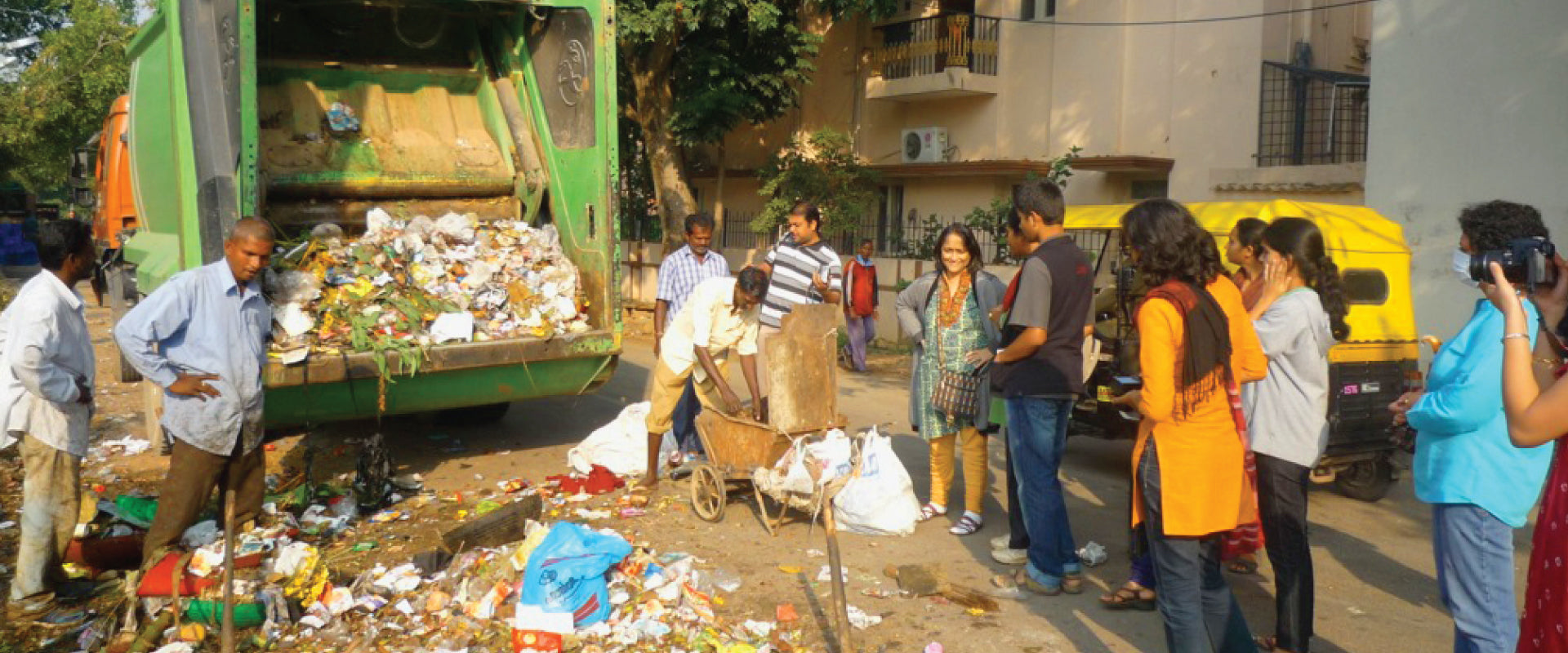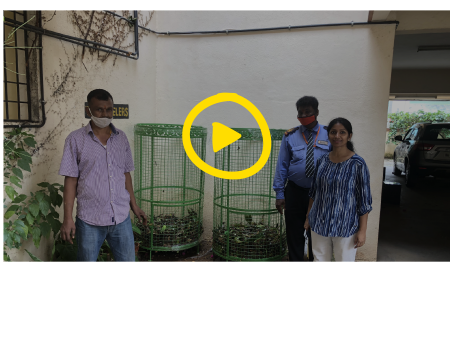The corridor is the highway to the landfill!

“Architecture and design is more than a tool to build, but a tool to change things in shaping the world around us and our experiences in it” David Orr
Building Green.
Over the last 15 years the real estate sector has done a lot of work to reduce the emissions of built habitats. Green certifications are both a business imperative as well as an ESG imperative. The focus has been to reduce the carbon footprint of the process of creating a building. There is a robust ecosystem that has grown around this to support the different stages of the project implementation, from material procurement, material choices, construction protocols, right up to assessments and certifications. Working towards a Green LEED certificate has become easier and more accessible. This is the good news!
While builders did not have to think about paying attention to the carbon footprint of their constructions before, it was a combination of awareness, change in climate, and a push for new norms coupled with legislation that has almost forced their hand.
What about the carbon footprint of the building post-handover? Most builders have a pressure to utilize their spaces for “desired amenities” and end up allocating a fraction of the space needed for waste to be managed post occupancy. Architects are also not clear on how to design for better waste flows and how people behave around the materials they dispose. What the real estate sector is not acknowledging is that how a building is designed effects the operational efficiency of resource recovery and creating circular flows of materials.
The next 7 years
Experts predict that -
We are expected to build at least 4 times more in the next 7 years than we have before.
We are expected to at least double our consumption across some areas.
In this scenario we can expect at least double the waste to be generated in our cities – large and medium and small. A large portion of this waste will come out of our living spaces, our homes.
And what are we doing to prepare for this eventuality? The question is are we putting in the plumbing to let this waste flow into closed loops – repair, reuse, recycling, composting?
What do you think?
The answer is no. We are not putting in the plumbing to deal with this coming deluge since we think we are doing a reasonably good job so far and we have the promise of technologies like waste to energy plants that will stand by us.
And what do we mean by plumbing?
Plumbing is a combination of interventions that will help the flow of waste to become circular in our cities. While these apply to all the phases and spaces through which materials move from creation to forming to distribution, purchase, use and disposal, I am focusing on the building of dense living spaces.
The plumbing package -
- Structural changes.
- Making spaces, products, and technology desirable
- Process to manage flows.
- Telling the story
- Policy – incentives.
Structural changes
These are the sizes, forms and spaces locked into a built environment at the design stage, often difficult to retrofit. For example, the corridor size, lift sizes, waste collection and storage spaces, spaces of disposal where vehicles are used to load waste for recycling or repurposing.
Let’s look at the humble corridor –
If we look at the spaces where we live, most corridors are just viewed as means to get to the home. The badly designed corridor is the first point of failure of good waste management.
For example, Flat 302 C has a family that subscribes to certain social and cultural norms so will chose to leave their wet waste out of the house every night. Since collection is in the late morning it will lie there and be open to spillage, or vandalism.
Required: a solution to leave waste out overnight
In Flat 606 the kids leave the bicycles and footwear outside and the waste they leave out adds to the mess upsetting neighbors. The “mess” is then attributed to waste and perpetuates a dislike to engage with the materials we consume and discard.
Required: a solution to make corridors look “neat” and handle our ways of living
In one community we worked with waste was collected manually from door to door by hand and in plastic bags and the housekeeping staff were not allowed to use the small lifts since they would smell (this was the norm this community had set).
Required: a solution for waste movement
In one community there was no space to store waste once collected, so even when they wanted to sort and send for recycling, they could not, and the waste was shipped to landfills.
Required: space for storing waste till it goes for recycling and space for community composting.
Another community has their exit gates in such a way that the vans that collected the material for recycling could not access it because of the size of the vehicle, this led to extra costs for the community and more work for the staff.
Required: Material recovery vehicles access that is not extra work and is designed for different vehicles.
Flat 203 gives out very little waste and Flat 506 gives out mixed waste often without segregation. Housekeeping staff have tried getting Flat 506 to segregate but are met with refusal and denial in front of supervisors or evangelists from the building.
Required: Data capture and management system to help monitor flows and help understand composition of materials and trends over time. Data that will help incentivize or penalize.
When we talk of examples like this, most people cannot see how this really matters. They feel these are trivial details and not worth the effort to invest time on. But recall how we incorporated the washing machine into our lives.
Remember 25 years ago, the top loading washing machine sat in the bathroom with the outlet feeding into the bathing area. Where else would you place it? We used to wash our clothes in the bathroom in flats, so naturally that was where it was first placed. It now finds pride of place in the kitchen or utility or balcony cum utility. Now it is unthinkable for a flat not to have a washing machine inlet and outlet built somewhere – but not in the bathroom!
The washing machine outlet and inlet were seen as a business imperative – not nice to have. Customers began to check for this when buying a new home!
The challenge now is to get builders to see the business imperative in investing in structural changes for circular flows. These are still not explored, and customers do not buy homes based on how easy the spaces help manage their waste better.
I believe that as our cities grow larger and denser the costs of transporting materials “away” and legislation from municipalities to reduce landfills will force the real estate sector to think about these seemingly minor changes even when they would rather believe in the promise of centralized technologies. From the work we have done in this sector, however, we know getting them to begin work on these “minor” changes is hard.
What is another point of view on the role of technology.
Builders really think that large technologies will be their way of managing waste coming out of their buildings.
We have watched as decision makers of built environments and governments have put their faith in vendors of technologies of pyrolysis, waste to energy plants, large material recovery projects to manage the waste that their finished buildings will churn out. It’s only now some of them are waking up to the fact that these are hard to maintain over time, need subsidies and have diminishing returns so perhaps their promise is overrated.
Policy makers and architects in other parts of the world are working to integrate waste processing and circular flows into spaces where generators of waste have a chance to engage and experience the stages, in the hope that it will help nudge the demand for a new paradigm of dealing with our materials and consumption.
“If architects and designers become engaged in the conversation of waste management and other industrial processes that support the demands of the city, they can begin to repair the physical and mental separation of waste and public activity while introducing cultural, economic, and environmental value in waste infrastructure.” Jeannine Muller
In our context it is also important to remember that our current waste recovery rates are what they are largely due to the informal band of people who sort, recycle, and repurpose – the hidden army that keeps India from drowning in its waste. We need to choose technologies and pathways that enhance their position and role in our cultural and social landscapes.
The value of making waste look good
Have you seen a great material recovery center in any flats or apartments you have lived in or visited? Where it was stylish like a lobby with great lighting, space, order? Very little thought is put in spaces allocated to waste, and the result is it cements the idea that waste is to be far away from our everyday – in dark spaces where only “waste workers” will go. We lose our opportunity to nudge a new behavior around resources.
There are now a growing number of facilities around the world that are seeking to debunk the myth that waste needs to look “dirty”. For example this center in Sharjah designed by Zaha Hadid or Copenhagen’s ski slope waste to energy plant.
Studies have shown that there is a better recycling rate when waste bins, trolleys, tools are well designed and placed in spaces that look good, either at home or in the workplace. The way products look can either help or stall waste flows. Which means we reduce the lifespan of a material.
At Daily Dump we can vouch for this, time and again people change their relationship with waste if it looks accessible, inviting or just convenient.
Government support
To drive these changes, it is important to incentivise the real estate sector to invest in research and design for a new system. Without this we will not be able to be ready for what is going to come. The change needs acceleration, smaller builders often do not have the recourses to do this, and many buildings will be built by them. Ideally a multidisciplinary team of practitioners with deep knowledge of the waste sector along with architects, designers, IT professionals, government, homeowners, housekeeping staff is best to ideate and create a new paradigm. We need our best minds to put their efforts to bring fresh ideas into this space.
The time for folks in the real estate industry to future proof their designs and incorporate these needs is now!
We at Daily Dump as a design led Brand are looking to work with any Builder or Architectural firm to co-create these new interventions. If you are interested do reach us at hello@dailydump.org. If you would like our presentation outlining these ideas in detail do email us and we will send you a copy!
Poonam Bir Kasturi
Daily Dump
July 2023
Some additional resources
https://www.zerowastedesign.org/
Unblackboxing Waste Management in Practice. A Set of Actions Enabling Circular City Making




